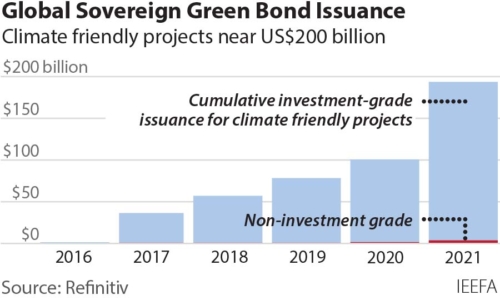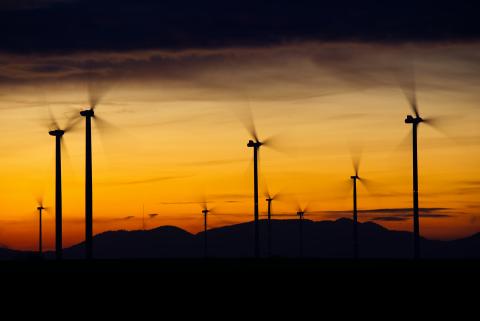IEEFA India: Sovereign green bond is a major step in greening public expenditure

Finance Minister Nirmala Sitharaman in her Budget 2022 speech announced the government will increase capital expenditure to a massive Rs7.5 trillion (US$100 billion) in the next fiscal year. This is in line with Prime Minister Narendra Modi’s announcement of an ambitious Rs100 trillion (US$1.35 trillion) national infrastructure plan in his Independence Day speech on 15 August 2021.
Several economists have applauded the huge push for infrastructure in the budget, yet there is concern that the budget is not green enough to help India meet its target of net-zero emissions by 2070 and build climate-resilient infrastructure. The budget announcement that stands out in terms of boosting green investment is the government’s promise to issue a sovereign green bond.
Huge investor demand for sovereign green bonds
Since the first issuance in December 2016, 27 countries have issued sovereign green bonds for climate change related projects, mobilising cumulative capital of US$194 billion.
France is the largest sovereign issuer to date, raising total capital of US$51 billion, followed by Germany at US$27 billion and the United Kingdom at US$21.6 billion. These bonds were oversubscribed by 8-12 times — a sign of huge investor demand.
A sovereign green bond would position India as a leader among the major emerging markets
Developing markets, including Serbia, Nigeria, Egypt, Colombia, Fiji, Indonesia and Benin, have also issued sovereign green bonds. The proceeds were allocated to climate mitigation or adaptation projects.
Given its investment-grade status, India’s sovereign green bond could attract the much-needed new pool of capital to finance the country’s green transition. Furthermore, issuance of a sovereign green bond would position India as a leader among the major emerging markets, especially among BRICS nations as none have issued such a green bond yet.

Sovereign borrowings offer significant benefits
Issuing an Indian sovereign green bond could catalyse more Indian corporate green issuances, adding to the current US$1.86 trillion pool of global green bond investments.
Sovereign green bonds have been issued with an average tenor of 14 years — the longest being 40 years issued by the Chilean government in 2021 — drawing long-term investors such as pension funds, insurers and those with a focus on environmental, social and governance (ESG) issues. Longer maturities can lower the borrowing cost for green projects.
The promise to issue a rupee-denominated sovereign green bond is an important step
In addition, a tighter interest rate spread has been observed with green bond issuances. This is important in light of rising inflation risk, though the spread is influenced by several macro-economic factors.
The government’s promise to issue a rupee-denominated sovereign green bond is an important step in the right direction. It should also consider issuing the rupee-denominated sovereign bond offshore (rupee-denominated bonds issued outside India are popularly known as masala bonds). This would provide benchmark pricing for future Indian corporate issuances, improve the liquidity of the rupee in foreign markets and avoid foreign currency risk.
The path to greening public expenditure
While the government’s seriousness in meeting the net-zero goals will be determined by the “greenness” of the projects to be funded using sovereign green bonds, its ability to identify projects that are most in need of financing is equally strategic. This would reflect well on the government’s credibility as a green bond issuer.
Sovereign green bonds have been allocated to a variety of climate adaptation and climate mitigation projects, with most of the proceeds going to clean transport, followed by climate change adaptation projects and aquatic biodiversity conservation. Other projects that have received sovereign bond proceeds include energy efficiency, land preservation and renewable energy infrastructure.
The bond proceeds should fund ‘dark green’ projects: climate-resilient public infrastructure
To attract serious green investors, the Indian government should put forward “dark green” projects as part of its sovereign green bond framework; in particular climate-resilient public infrastructure that is crucial to decarbonising the economy but is difficult to fund with private capital.
In India, 75% of districts – home to more than 638 million people – are classified as extreme climate event hotspots. The frequency of extreme climate events such as cyclones, droughts and floods pose a serious risk to infrastructure. Hence, injecting climate resilience into core infrastructure such as roads, bridges and electricity transmission and distribution networks should be one of the major focuses of the sovereign green bond.
Transitioning public transport from fossil-fuelled conventional buses to electric buses has also been a challenge due to large upfront costs and limited low-cost, long-term financing options. Sovereign green bonds can support the spread of electric buses and allied charging infrastructure in India by providing cost-effective financing options.
New technologies such as energy storage — to support India’s grid integration of 500 gigawatts (GW) of non-fossil energy capacity by 2030 — and green hydrogen projects also require the government’s support to be financially viable for private investors.
This article first appeared in The Economic Times
By Saurabh Trivedi, Research Analyst, Institute for Energy Economics and Financial Analysis (IEEFA)
Related articles:
IEEFA: Innovative financing can help India achieve its renewable energy goals
IEEFA: Green bonds are driving cost-effective finance to clean energy in India
IEEFA: Renewable energy investment in India bounces back from COVID-19 slowdown












